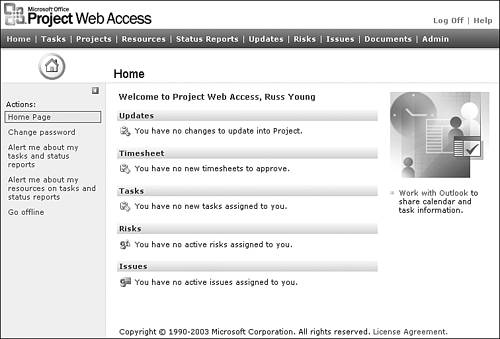Introduction to Enterprise Collaboration
| < Day Day Up > |
| Chapters 24 through 27 describe how people across the organization use project and resource management functions within Project Web Access 2003. In this chapter, we discuss several Project Web Access collaboration features, including
Table 28.1. |
| New Professional Edition Feature | Project Management Functions |
|---|---|
| Multiple timesheet approvers | Allows staff and resources manager to review and approve timesheets before posting to projects |
| Timesheet lockdown periods | Provides time-data security to prevent changes |
| Risk management | Enables project managers to record and track progress to address risks |
| Outlook integration | Improves information exchange between Microsoft Outlook and Microsoft Project 2003 Professional |
Project Server 2003 provides a robust environment supporting data storage and exchange so project teams can share information. Project data and associated documents are stored within the Project Server database repository and are managed by people who have access permissions to that data.
Project Web Access users can review, discuss, and exchange information about each project stored in the Project Server database repository. Each team member uses Project Web Access functions to review and update information like: timesheets, associated project documents, risks, issues, and status reports . All of this information is stored and managed through the set of functions found within Project Web Access as illustrated in Figure 28.1.
Figure 28.1. Project Web Access provides several collaboration functions such as Tasks, Status, Updates, Risks, Issues, and Documents.

Project managers use Microsoft Project 2003 Professional to develop work breakdown structures, assign team members to working tasks, and save project schedules into the Project Server database repository. Each time the project manager updates a project schedule, Project Server automatically manages information storage locations and transmits messages to team members and others who need to review updated project information.
Team members, project managers, and other Project Web Access users see the project information and can interact with the data using Project Server electronic collaboration techniques. As team members update project collaboration data, automatic messages are again transmitted to the subscribers so they can review the changes and stay informed about key project status and content.
The sections within this chapter give you more information about the key Project Server collaboration features and how to use the functions to manage project information.
 For information on Project Server architecture, see "System Architecture and Requirements," p. 968 .
For information on Project Server architecture, see "System Architecture and Requirements," p. 968 .
Understanding Enterprise Collaboration Flow
The Project Server architecture automatically creates and manages the internal data structures and information storage locations. When a project schedule is defined and stored within the Project Server 2003 database repository, the architectural components of Windows SharePoint Services are directed by Project Server to create the needed storage locations for that project.
Once the Windows SharePoint Services information stores are created, Project Web Access users are given access to that information based on their individual Project Server security permissions to a project. If the Project Web Access administrator changes user permissions, Project Server automatically directs Windows SharePoint Services to update permissions accordingly .
The flow diagram in Figure 28.2 illustrates these general principles.
Figure 28.2. Project Server manages Windows SharePoint Services information stores.

Once the project schedule collaboration infrastructure is established, then Project Web Access users can view project data and use the collaboration features to share information.
| < Day Day Up > |
EAN: 2147483647
Pages: 283